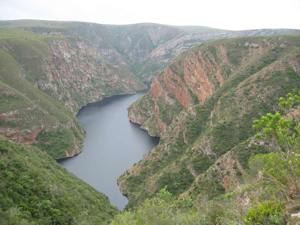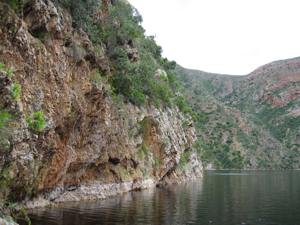Cyrtanthus flammosus
Cyrtanthus flammosus Snijman & van Jaarsv.
Family: Amaryllidaceae
Common names: Kouga flame lily (Eng.); Kouga-vlamlelie (Afr.)
Introduction
This exciting ornamental bulbous plant with its large solitary orange-red flower is only known from the cliffs along the Kouga River and adjacent territory in the Eastern Cape. It shows potential as an indoor perennial as well as for breeding and development of new cultivars.

Description
Description
The ovoid evergreen bulbs (about 40 x 40 mm) are solitary, the upper portion partially exposed and covered with dry brown papery scales. The roots are slightly fleshy. Leaves 2-4, spreading, oblong-spear-shaped (lanceolate), ascending to recurved, up to 290 × 20 mm, thick-textured, greyish green and tinged reddish brown.

The inflorescence is usually single-flowered (occasionally with two flowers), ascending-spreading, with a hollow inflorescence stalk (scape) up to 170 mm long. The large flower (perianth) is up to100 mm in diameter. The floral leaves are bright orange-red. The plant flowers in late summer and autumn (March).

The fruiting capsule is solitary, oblong, 70 × 5 mm, tapering slightly at both ends, ascending when dry. The seeds are black, pendulous, 15 × 5 mm, flat, lobes becoming recurved, part containing embryo 6 × 5 mm with wing towards one side (aerobatic propeller type), dispersed by wind during midwinter.
Conservation Status
Status
The Kouga flame lily is only known from a few sites along the Gamtoos River and its tributaries such as the Kouga River and Grootrivier near Hankey and Patensie. Its conservation status in the Red List of South African Plants (Snijman & Victor 2009) is Critically Rare as it is known from only one site, but not threatened. However, although certainly very localized on cliffs, the population is healthy, and grows inside a reserve. The sites where C. flammosus grows are difficult to reach and large portions are inaccessible, being on vertical cliff faces. Fortunately plants have also been well established in cultivation. A more realistic conservation status of this species is 'Least concern', due to its healthy undisturbed population and its presence within the borders of a reserve.

Distribution and habitat
Distribution description
Mainly south-facing quartzitic sandstone cliff faces overlooking the Kouga River along the Kouga Dam (250-500 m above sea level). Plants grow on shallow soil on small to fairly large inaccessible rocky ledges. Summers are hot and dry, the average daily maximum temperature is about 27°C and the average daily minimum temperature about 12°C. The winters are cooler but frost is a rarity or absent. Rainfall occurs mainly in summer and winter, about 400-500 mm per annum.

The plants grow in Gamtoos Thicket of the Albany Thicket Biome (Mucina & Rutherford 2006). Associated cliff dwellers include: Adromischus cristatus var. schonlandii , Aloe pictifolia , Cotyledon tomentosa subsp. tomentosa, Crassula perforata subsp. kougaensis , Gasteria glomerata, Haworthia gracilis var. picturata, H. viscosa, Othonna lobata and Plectranthus verticillatus . The rocks in its habitat consist of quartzitic sandstone of the Peninsula Formation (Cape Supergroup).
Derivation of name and historical aspects
History
The type collection of Cyrtanthus flammosus was made along the Kouga Dam on a boating expedition searching for Aloe pictifolia, on 11 November 1993. It was named by the Amaryllid specialist Dee Snijman and the author in the Flowering Plants of Africa in 1995. The Latin specific name flammosus, meaning 'like a flame', pertains to the bright orange red colour of the flowers.
Ecology
Ecology
Cyrtanthus flammosus is an obligate (not able to grow anywhere else) cliff dweller growing on ledges difficult to reach. The plants are solitary (bulbs usually not exposed, sometimes the upper part exposed), with one to two pairs of leaves which are glaucous and leathery, well adapted to dry conditions. The bulb is covered with brownish papery tunics forming a prote cti ve cover. Exposed parts of the bulb are photosynthetically a ctive.
The habitat is shared with C. montanus and C. labiatus, but unlike our species, these grow on top of the substrate and produce many bulbils (from the base of the bulb), acting as a vegetative propagation back-up. The Kouga flame lily ( C. flammosus ) is one of nine obligate cliff-dwelling Cyrtanthus species. The others include C. falcatus, C. flanaganii, C. herrei, C. inaequalis, C. junodii, C. labiatus, C. montanus, and C. sanguineus.
C. flammosus is related to two non-cliff-dwelling species, Cyrtanthus guthrieae (Bredasdorp, Western Cape) and the coastal C. elatus (George to Humansdorp, Western to Eastern Cape) and differing from these by its glaucous, leathery leaves and larger, conspicuous flowers. The presence of a highly conspicuous large solitary flower (from a reduced inflorescence) is known as `enriched flowering' and compensates for the lack of bulbil formation when compared to C. montanus and C. labiatus (Van Jaarsveld 2011).
The flower shape (large open flower) of the Kouga flame lily suggest a butterfly pollinator such as Meneris tulbaghia. The relative large-winged seeds, carried on elongated pods, are released during summer. They are of the aerobatic propeller type, comparable to a samara (a 1-seeded winged fruit) (Van der Pijl 1982) and are dispersed by wind.
Uses
Use
The plants have ornamental value and are grown at Kirstenbosch National Botanical Garden, from where they have been distributed. They are easily grown from seed.
Growing Cyrtanthus flammosus
Grow
Cyrtanthus flammosus is a solitary species which does not proliferate from bulbils, as found in so many other cliff-dwelling bulbous species. It grows best as a pot plant in a well drained quartzitic sandstone soil mixture in full sun or a partial shady position. Water during spring and summer but do not overwater as the bulb can succumb to fungal diseases and rot. Reduce watering during the cooler winter months. Plants react well to an occasional organic fertiliser which can be added to the watering.
Seed is best sown during spring in a sandy well-drained mixture. Keep in partial shady environment. Cover with a thin layer of sand (1-2 mm thickness) and keep moist. Germination is within 3 weeks and the seedlings can be transplanted when they are big enough to handle. Plants are slow-growing but should flower during the third year after sowing.
The plants are best grown in subtropical coastal gardens or as a house plant in cold regions (Van Jaarsveld 2010). Place where they get sufficient light.
References
- Mucina, L. & Rutherford, M.C. (eds). 2006 . The vegetation of South Africa, Lesotho and Swaziland. Strelitzia 19. South African National Biodiversity Institute, Pretoria.
- Snijman, D.A. & Van Jaarsveld, E.J. Cyrtanthus flammosus in Flowering Plants of Africa 54: 100-103 (1995).
- Snijman, D.A. & Victor, J.E. 2009. In D. Raimondo, L. Von Staden, W. Foden, J.E. Victor, N.A. Helme, R.C. Turner, D.A. Kamundi, & P.A. Manyama (eds.) 2009. Red List of South African plants 2009. Strelitzia 25. South African National Biodiversity Institute.
- Van der Pijl, L. 1982. Principals of dispersal in Higher Plants . Springer-Verlag, Berlin, Heidelberg, New York.
- Van Jaarsveld, E.J. 2010. Water-wise gardening. Struik, Cape Town
- Van Jaarsveld. E.J. 2011. Cremnophilous succulents of southern Africa: diversity, structure and adaptations . Faculty of Natural and Agricultural Sciences(Department of Plant Science). Unpublished thesis. University of Pretoria.
Credits
Ernst van Jaarsveld
Kirstenbosch National Botanical Garden
July 2013
Plant Attributes:
Plant Type: Bulb
SA Distribution: Eastern Cape
Soil type: Sandy
Flowering season: Late Summer, Autumn
PH: Acid
Flower colour: Red
Aspect: Full Sun, Morning Sun (Semi Shade), Afternoon Sun (Semi Shade)
Gardening skill: Average
Special Features:
Horticultural zones









Rate this article
Article well written and informative
Rate this plant
Is this an interesting plant?
Login to add your Comment
Back to topNot registered yet? Click here to register.